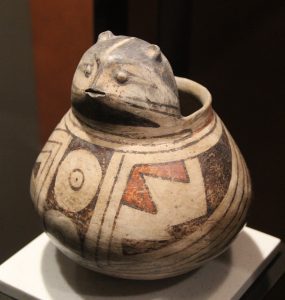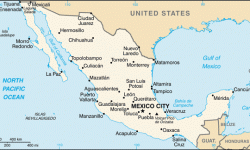Casas Grandes Artefacts Returned to Mexico from the US in 1997
Author: Donna Yates
Last Modified: 10 Apr 2025

Artefacts offered to undercover US federal agents by a man who claimed to have looted them from a Mexican cave.
Casas Grandes, also known as Paquimé, is a large archaeological site located in the northwestern part of the state of Chihuahua, Mexico. The site should not be confused with the similarly named Casa Grande archaeological site located in the US state of Arizona. The Puebloan-style architecture of the Casas Grandes includes “an estimated 2000 rooms, Mesoamerican style platform mounds, and ball courts” (Silva 2012). The site is known for its aesthetically appealing ceramics (Silva 2012).
There is a long and documented history of illegal looting in Chihuahua, particularly in the Casas Grandes area, and an equally long history of United States-based market actors and museums knowingly engaging with this looted material (see Kelley et al. 2011; Silva 2012). Silva (2012) notes that because the United States is only about 130 km away from the site, Casas Grandes represents “an ideal location where a market is extremely close to the source”.
Focusing specifically on the 1990s, archaeologists documented numerous incidents of looting at Chihuahua sites during that period. For example Kelley et al. (2011: 212) record major looting events at the Raspadura site in 1990 and 1991. Although Kelley et al. note that the Raspadura site looting was likely associated with an absentee landowner, generally looting at Chihuahua sites in the 1990s usually fit certain patterns. They have argued that visibility was a key factor: house mound sites were the most likely to be targeted by looters than flatter sites, and long droughts during the period reduced vegetation cover making such sites easier to see (Kelley et al. 2011: 213). They also note that these droughts exacerbated economic difficulties for the local population, perhaps inspiring them to supplement their income via artefact looting and sale.
In 1996 undercover federal agents approached a man named Rodolfo Acedo who was offering a rifle for sale (Associated Press 1996). Acedo offered to sell artefacts to the agents, claiming that he had personally looted them from a Mexican cave (Associated Press 1996). Acedo also claimed to have sold other objects to buyers in California and Colorado, and that he had been smuggling artefacts into the United States for about four years (Associated Press 1996). The agents paid Acedo $2000 USD for the pots, and Acedo offered them more artefacts shortly afterwards. Later the agents seized 31 artefacts from Acedo’s home and arrested him (Associated Press 1996). It was determined that the objects likely came from Casas Grandes.
Following his arrest, Acedo claimed that his story that he personally looted the artefacts was a lie meant to enhance his reputation (Associated Press 1996). He pleaded guilty to one count of smuggling and was sentenced to five years probation and community service (Associated Press 1996). The seized Casas Grandes artefacts were returned to Mexico on 10 October 1997 (Associated Press 1996).
[Image by Gary Todd, CC 0 1.0; This is not an image of one of the returned objects, rather it illustrates Paquimé ceramic style]
Works Cited
Associated Press (1996) Ancient artifacts returning to Mexico. 10 October.
Kelley, Jane H., David A. Phillips, A. C. MacWilliams, and Rafael Cruz Antillón (2011) “Land Use, Looting, and Archaeology in Chihuahua, Mexico: A Speculative History.” _Journal of the Southwest_ 53(2): 177–224. http://www.jstor.org/stable/41710084. Accessed on 29 August 2023.
Silva, Fabiola (2012) The Plundering of Paquimé: The History of Looting in Northwestern Chihuahua, Mexico. Master’s Thesis. University of Oklahoma. https://shareok.org/handle/11244/335827. Accessed on 29 August 2023.



